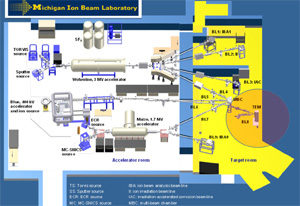We are excited to announce that the center’s collaboration with the Michigan Ion Beam Lab (MIBL) has begun, and users can now request training or service work on a 300 kV transmission electron microscope attached to an ion beam system. The microscope, an FEI Tecnai G2 F30 TWIN, is located at MIBL on the North Campus and can be used as either a regular TEM, or in its paired capacity for in-situ ion irradiation studies. This experimental setup makes University of Michigan one of only a few locations in the U.S. (and currently the only university in the country) to offer an ion beam and electron beam combination. (MC)2 research scientist Kai Sun and MIBL lab manager Ovidiu Toader will helm new projects and coordinate training at the MIBL facility.
The microscope will be of particular value to nuclear research groups, with applications that may extend more widely in the future. The initial motivation is to help design improved radiation-resistant materials for new generations of nuclear reactors. Primarily, interfacing the microscope with the accelerator allows for observation of changes in the microstructure of materials under ion irradiation that can help in understanding initiative damage in materials irradiated by neutrons. Because the research reveals high-energy ion beam effects on materials, it could also be useful for applications such as evaluating detector performance under radiation, or even medical treatments by ion beam (recent studies at other labs, for example, have investigated ion beam effects on tumors).
Two separate ion species can be combined for delivery to the TEM stage, which is invaluable for simulating the effects of neutron irradiation. Normally He ions are introduced to achieve this. The more ions that can be introduced to the TEM simultaneously, the closer conditions to those of neutron irradiation can be reproduced. (MC)2 and MIBL’s configuration would be the first of its type in the U.S. that can introduce two beams simultaneously—currently He and Kr.
The microscope can also be used as a general TEM independently from the attached ion implanter. In this function, it is similar to the TEMs in the (MC)2 lab. The TF30 has a lower resolution in STEM mode than the two aberration-corrected TEMs, but a higher resolution in TEM mode, large tilt range, and a higher e-beam energy that can be especially useful for thicker samples.
The scope is available now to registered U-M users, as well as industry and external academic researchers. The center’s regular rates and user policies apply to all microscope use.
Any questions?
Contacts: Kai Sun, kaisun@umich.edu; Ovidiu Toader, ovidiu@umich.edu
Full system details: https://mibl.engin.umich.edu/300-kv-fei-tecnai-tem

